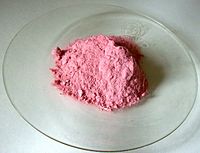- Cobalt(II) acetate
-
Cobalt(II) acetate Cobalt(II) acetateIdentifiers CAS number 71-48-7  , (anhydrous)
, (anhydrous)
6147-53-1 (tetrahydrate)PubChem 6277 ChemSpider 6041 
UNII 3XC4P44U7E 
Jmol-3D images Image 1 - [Co+2].[O-]C(=O)C.[O-]C(=O)C
Properties Molecular formula C4H6CoO4 Molar mass 177.02 g mol−1 Appearance Red solid Density 1.71 g/cm3 (tetrahydrate) Melting point 140°C (loses water)
Solubility in water Soluble Hazards MSDS J.T. Baker MSDS NFPA 704  (verify) (what is:
(verify) (what is:  /
/ ?)
?)
Except where noted otherwise, data are given for materials in their standard state (at 25 °C, 100 kPa)Infobox references Cobalt(II) acetate is the cobalt(II) salt of acetic acid. It may also be found as the tetrahydrate.
It may be formed by the reaction between cobalt oxide or hydroxide and acetic acid:
- CoO + 2 HC2H3O2 → Co(C2H3O2)2 + H2O
Cobalt(II) acetate may be reacted with salenH2 to give salcomine, an oxygen-transport compound:[1]
- Co(OAc)2 + salenH2 → Co(salen) + 2 HOAc
Cobalt(II) acetate is harmful if swallowed or inhaled. It may cause an allergic skin reaction. Chronic exposure may affect heart, thyroid, lungs, and kidneys. [2]
References
- ^ Appleton, T. G. (1977). "Oxygen Uptake by a Cobalt(II) Complex". J. Chem. Ed. 54 (7): 443. doi:10.1021/ed054p443.
- ^ http://www.mallbaker.com/americas/msds/english/c4895_msds_us_default.pdf%7CMallBaker MSDS

This article about an organic compound is a stub. You can help Wikipedia by expanding it.


